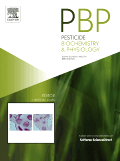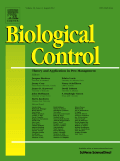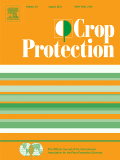
Pesticide Biochemistry and Physiology
Scope & Guideline
Transforming agricultural ecosystems with pioneering research in pesticide biochemistry.
Introduction
Aims and Scopes
- Pesticide Resistance Mechanisms:
Research on the genetic, biochemical, and physiological mechanisms through which organisms develop resistance to pesticides, including studies on mutations in target sites and metabolic resistance. - Biochemical Toxicology:
Investigations into the toxicological effects of pesticides on non-target organisms, including studies on cellular and molecular pathways affected by pesticide exposure. - Pesticide Efficacy and Mode of Action:
Studies that explore the effectiveness and mechanisms of action of various pesticides, including novel compounds and natural products. - Environmental Impact Studies:
Research focusing on the environmental consequences of pesticide use, including studies on soil, water, and non-target species. - Biocontrol and Integrated Pest Management (IPM):
Explorations of biological control agents and their interactions with pesticides, contributing to the development of integrated pest management strategies. - Molecular and Genomic Approaches:
Utilization of molecular biology techniques, including transcriptomics and proteomics, to understand pesticide interactions at the genetic and protein levels.
Trending and Emerging
- RNA Interference (RNAi) Applications:
There is a growing interest in RNAi technology for pest control, with studies focusing on the use of dsRNA for targeting specific genes in pest species to enhance control efficacy. - Natural Products and Biopesticides:
Research on the efficacy of natural products and biocontrol agents is on the rise, reflecting a trend towards sustainable pest management solutions. - Omics Technologies:
The use of transcriptomics, proteomics, and metabolomics to study pesticide effects and resistance mechanisms is increasingly popular, allowing for a deeper understanding of biochemical pathways. - Microbiome Interactions:
Emerging research is focusing on the interactions between pesticides and the microbiome of pests, highlighting the importance of microbial communities in pest resistance and pesticide efficacy. - Cross-Resistance and Fitness Costs:
Studies investigating the fitness costs associated with resistance mechanisms and how these affect pest populations are becoming more prominent, emphasizing the ecological implications of resistance. - Ecotoxicology and Non-Target Effects:
An increasing emphasis on the ecotoxicological impacts of pesticides on non-target organisms and ecosystems is evident, reflecting a broader environmental concern.
Declining or Waning
- Traditional Chemical Pesticides:
Research focusing exclusively on conventional chemical pesticides has been decreasing as the field shifts towards biopesticides and integrated pest management strategies. - Single-Specimen Studies:
There is a noticeable decline in studies that focus on a single organism without considering ecological interactions, as there is a growing emphasis on multi-species and ecosystem-level impacts. - Basic Toxicology Studies:
Basic studies on the toxic effects of pesticides without a focus on resistance mechanisms or ecological implications are becoming less common, reflecting a shift towards more applied research. - Laboratory-Only Experiments:
Research that solely relies on laboratory experiments without field validation is less frequent, as there is an increasing demand for studies that reflect real-world conditions.
Similar Journals

NEMATOLOGY
Unraveling the Secrets of Soil and NematodesNematology is a prominent journal published by BRILL, focusing exclusively on the multifaceted realm of nematodes and their ecological, agricultural, and biological implications. With an ISSN of 1388-5545, this esteemed journal serves as a vital platform for researchers, professionals, and students dedicated to advancing knowledge in Agronomy and Crop Science and Ecology, Evolution, Behavior, and Systematics. Established in 1999 and continuing its mission until 2024, Nematology holds a Q2 ranking in Agronomy and Crop Science and a Q3 ranking in Ecology as of 2023, indicating its significant impact within these fields. Published in the Netherlands, this journal is accessible through various options, providing vital insights into nematological research and its applications. Researchers from around the globe are encouraged to explore, submit manuscripts, and contribute to the evolving discourse within this specialized yet pivotal area of study.

SPANISH JOURNAL OF AGRICULTURAL RESEARCH
Connecting Research and Practice in AgricultureThe Spanish Journal of Agricultural Research (ISSN: 1695-971X, E-ISSN: 2171-9292), published by the prestigious Consejo Superior Investigaciones Cientificas (CSIC), serves as a vital resource for those engaged in the fields of agronomy and crop science. Established as an Open Access journal since 2003, it aims to foster the dissemination of innovative research and practical applications related to agricultural practices and sustainability. With its Q3 category in Agronomy and Crop Science and a Scopus ranking of #224 out of 406, the journal provides an accessible platform for scholars to share valuable findings that enhance agricultural productivity and environmental stewardship. Covering research from 2006 to 2024, this journal continues to be instrumental for researchers, professionals, and students eager to remain at the forefront of agricultural science advancements.

Agronomy-Basel
Nurturing the Future of Agronomy with Cutting-Edge ResearchAgronomy-Basel is a leading international journal dedicated to advancing the field of agronomy and crop science, published by the respected MDPI. Since its inception in 2011, this open-access journal has provided a vital platform for the dissemination of high-quality research, featuring innovative studies and reviews that contribute to the understanding of agricultural practices and crop management. With an impressive impact factor and ranked in the Q1 quartile of its category for 2023, Agronomy-Basel has established itself as a premier resource in the realm of Agricultural and Biological Sciences, achieving a commendable rank of #62 out of 406 in its field, placing it in the 84th percentile. The journal targets researchers, professionals, and students who are dedicated to enhancing agricultural sustainability and productivity. Located in Basel, Switzerland, the journal's commitment to open access empowers global accessibility to flourishing agricultural advancements, thus fostering collaboration and innovation across the globe.

BIOCONTROL SCIENCE AND TECHNOLOGY
Cultivating Sustainable Practices Through Rigorous ResearchBIOCONTROL SCIENCE AND TECHNOLOGY is a premier, peer-reviewed journal published by Taylor & Francis Ltd that specializes in the dynamic fields of Agronomy and Insect Science. Established in 1991, this journal has garnered a reputation for disseminating high-quality, impactful research with an impressive 2023 Scopus rank of 53 out of 181 in Insect Science and 153 out of 406 in Agronomy, placing it in the Q2 category for both fields. With its ISSN 0958-3157 and E-ISSN 1360-0478, the journal serves as a vital resource for researchers, professionals, and students dedicated to advancing understanding and innovation in pest management and biocontrol strategies. Although not an open-access journal, it offers comprehensive insights that are crucial for professionals aiming to tackle agricultural challenges and enhance food security. The journal’s continuous coverage from 1991 to 2024 ensures that it remains at the forefront of significant advancements in biocontrol, making it an essential read for anyone interested in sustainable agricultural practices and integrated pest management.

BIOLOGICAL CONTROL
Transforming Agricultural Practices through Cutting-Edge ResearchBIOLOGICAL CONTROL, published by Academic Press Inc Elsevier Science, is a prestigious journal focusing on the advancement of knowledge in the field of biological pest control and integrated pest management. With a high-impact factor reflecting its significant contributions to agronomy and insect science, it has secured elite positions in both Q1 categories as of 2023. The journal ranks within the top 6% and 12% of its fields on Scopus, making it an essential resource for researchers and professionals dedicated to sustainable agricultural practices and ecological balance. With its comprehensive exploration of theoretical and applied studies from 1991 to 2024, BIOLOGICAL CONTROL serves as a critical platform for disseminating innovative research and promoting dialogue among scholars, students, and practitioners. Although the journal follows a subscription-based access model, it consistently attracts contributions that shape the future of pest management strategies.

JOURNAL OF PESTICIDE SCIENCE
Shaping the future of insect science and pesticide safety.JOURNAL OF PESTICIDE SCIENCE, published by the PESTICIDE SCI SOC JAPAN, serves as a crucial conduit for scientific discourse in the fields of pesticide science, toxicology, and insect science. Since its inception in 1975 and now an Open Access journal since 2020, it aims to disseminate high-quality research findings, reviews, and innovative methods, directly supporting advancements in both agricultural sustainability and public health. With an ISSN of 1348-589X, the journal currently holds a Q3 ranking for Health, Toxicology and Mutagenesis, and a commendable Q2 rank in Insect Science—a testament to its relevance and impact within the scientific community. As of 2023, it is recognized in Scopus with notable rankings in various categories, emphasizing its significance among peers. The journal is headquartered at TOKYO UNIV AGR DEPT OF AGR CHEM, TOKYO, JAPAN, and remains committed to fostering collaboration and promoting vital research that addresses the challenges posed by pesticide use. Researchers, professionals, and students alike are encouraged to engage with this essential resource, contributing to the ongoing dialogue regarding pest management and environmental health.

Bioagro
Connecting minds through groundbreaking agricultural science.Bioagro is an esteemed academic journal dedicated to advancing research in the field of Agricultural and Biological Sciences. Published by the University Centroccidental Lisandro Alvarado in Venezuela, this journal has made significant strides since its inception in 2008, with a focus on delivering high-quality research publications that address contemporary challenges in agriculture and biology. Recognized for its contributions, it holds a Q3 ranking in the Agricultural and Biological Sciences (miscellaneous) category as of 2023, and it ranks #125 out of 221 in its field, placing it in the 43rd percentile. Although it operates on an Open Access model, Bioagro strives to provide broad access to innovative research, thereby fostering collaboration and knowledge dissemination among researchers, professionals, and students. With a commitment to include a wide range of topics, the journal aims to be a pivotal platform for exploration and dialogue in agricultural sciences, ensuring that key findings reach both scientific and practitioner audiences. Located in Barquisimeto-Cabudare, Lara, Venezuela, Bioagro invites submissions that contribute to the global discourse on sustainable practices and innovations in agriculture.

Pesquisa Agropecuaria Tropical
Advancing agricultural knowledge for a sustainable future.pesquisa Agropecuaria Tropical is a premier Open Access journal dedicated to advancing the knowledge and practices within the field of agronomy and crop science. Since its inception in 1971, this peer-reviewed journal, published by the Universidade Federal de Goiás, has played a pivotal role in disseminating high-quality research from Brazil and beyond. Operating under an Open Access model, it ensures that scholarly articles are freely accessible, thereby fostering greater collaboration and innovation. With a Scopus ranking placing it in the 32nd percentile among its peers in agricultural and biological sciences, and a current classification in the Q3 category of agronomy and crop science, the journal serves as an essential resource for researchers, professionals, and students alike. As it continues its publication journey from 2010 to 2024, it remains committed to contributing valuable insights and advancements in the agricultural sector, ultimately influencing sustainable practices and food security.

Journal of Central European Agriculture
Sharing Critical Research for a Thriving Agricultural CommunityThe Journal of Central European Agriculture, with ISSN 1332-9049 and E-ISSN 1332-9049, is an esteemed platform published by UNIV ZAGREB, FAC AGRICULTURE that caters to the dynamic fields of agronomy, crop science, and animal science. Since its establishment in 2000, this Open Access journal has played a crucial role in disseminating critical research findings while fostering collaboration among academics, researchers, and professionals within the agricultural community. The journal, which is based in the heart of Croatia, spans a rich history of scholarship, with its content available for free to readers and contributors alike. As reflected in its current standings, the journal has achieved a Quartile 3 ranking in Agronomy and Crop Science and Quartile 4 in Animal Science and Zoology for the year 2023, indicating its growing influence within these disciplines. With Scopus ranks placing it in the 32nd percentile among its peers, the Journal of Central European Agriculture is committed to advancing agricultural sciences not only in Central Europe but globally as it prepares for its converged years from 2007 through 2024. This journal serves as a vital resource for innovative research, practical applications, and a deeper understanding of agricultural challenges and solutions.

Crop Protection
Empowering researchers with high-impact agricultural insights.Crop Protection is a leading academic journal in the field of Agronomy and Crop Science, published by Elsevier Science Ltd, and recognized for its high impact demonstrated by an impressive Q1 quartile ranking in 2023. With its ISSN 0261-2194 and E-ISSN 1873-6904, this esteemed publication has been a crucial source of research since its inception in 1982, continuing to provide valuable insights and advancements in crop protection strategies through 2024. The journal serves a diverse audience, including researchers, professionals, and students, eager to explore pioneering findings in pest management, herbicide development, and sustainable agricultural practices. While the journal does not offer open access options, its rigorous peer-review process ensures the highest quality of scholarly articles that contribute significantly to the agricultural and biological sciences, maintaining its respected position with a Scopus rank of #63 out of 406 in its category, placing it in the 84th percentile. Engaging with Crop Protection not only enriches knowledge but also promotes innovative solutions for global agricultural challenges.